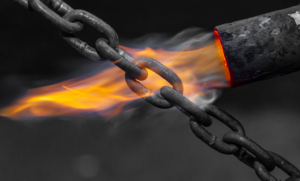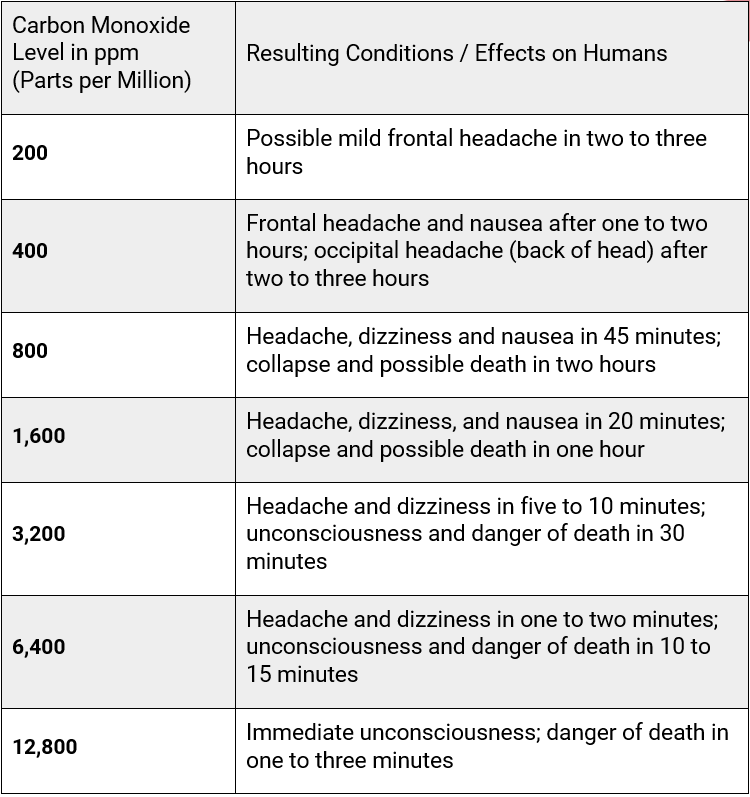Carbon Monoxide Facts – Quick Tips

Basic Carbon Monoxide Facts
Carbon monoxide (CO) is an odorless, colorless, tasteless gas that is slightly lighter than air. It is sometimes called carbonic oxide, exhaust gas or flue gas. It becomes a liquid under high pressure. It can also kill within minutes in high concentrations.
Where Does Carbon Monoxide Come From?
Carbon monoxide is produced by the incomplete combustion of any fuel that contains carbon. This includes gasoline, natural gas, oil and propane, as well as coal and wood products.
What Are the Main Sources of Carbon Monoxide?
At home, sources of carbon monoxide include gas- and oil-burning appliances such as furnaces, dryers, water heaters, ovens, wood-burning stoves, charcoal grills and automobiles. In the workplace the most common source of exposure is from internal combustion engines. It’s easy to forget that propane powered forklifts produce carbon monoxide because the output is normally very low. The levels are affected by dirty air filters, engines in need of tuning, fuel systems needing service and the age of the forklift. Other potential workplace sources include:
- Operations near furnaces, ovens, generators, forges and kilns when they are fired up to operating temperatures
- Organic chemical synthesis processes including some petroleum-product processes
- Gasoline-powered tools such as high-pressure washers, welders and pumps
- Metallurgical processes
- When air is supplied from reciprocating oil-lubricated compressors
Because many of these sources are only used in cold weather, carbon monoxide poisoning is considered by many to be a “seasonal” risk. However, carbon monoxide gas can build up in any enclosed or semi-enclosed space at any time. Exposure can occur through inhalation of the gas and eye or skin contact with the liquid.
Carbon Monoxide Poisoning Symptoms
Carbon monoxide is a chemical asphyxiant. When inhaled, it bonds with the hemoglobin in the blood, which is responsible for carrying oxygen throughout the body. The carbon monoxide replaces the oxygen molecules in hemoglobin and deprives the heart, brain and body of the oxygen it needs to function. High concentrations can displace enough oxygen in your body to cause oxygen starvation.
The symptoms of low-level carbon monoxide poisoning include headaches, nausea, weakness, dizziness and confusion. Exposure causes a victim’s blood pressure to rise in an attempt to get more oxygen to the body. As a result, the skin might take on a reddish color. The symptoms at low levels are very similar to what a person might exhibit if affected by the flu or other common illnesses. Therefore, carbon monoxide is sometimes referred to as the “great imitator.”
As carbon monoxide exposure increases, more serious symptoms develop, including a lack of coordination, chest pain, vomiting and loss of consciousness. If exposed to carbon monoxide long enough, coma and death can occur.
What Is a Dangerous Level of Carbon Monoxide?
The Occupational Safety and Health Administration (OSHA) permissible exposure limit for carbon monoxide is 50 parts per million (ppm), or 55 milligrams per cubic meter (mg/m3) as an eight-hour time-weighted average (TWA) concentration. The National Institute for Occupational Safety and Health’s (NIOSH’s) recommended exposure limit (REL) is 35 ppm, or 40 mg/m3 TWA in eight hours. The American Conference of Governmental Industrial Hygienists (ACGIH) has assigned a carbon monoxide threshold-limit value (TLV) of 25 ppm or 28.6 mg/m3 for eight hours. A concentration of 1,200 ppm is considered immediately dangerous to life or health. This table lists common symptoms and effects on healthy adults at various carbon monoxide concentrations.

Source: Iowa State Department of Agricultural and Biosystems Engineering
Typically, upon removal from exposure to carbon monoxide, symptoms usually resolve themselves, unless there has been an episode of acute poisoning, which is typified by single exposure or multiple exposures to a chemical over a short period of time.
Carbon Monoxide Detectors
Detection is crucial because of the common sources of carbon monoxide and its inherent dangers. Detector tubes, diffusion tubes, color badges, portable gas monitors and household or industrial fixed-gas monitors are commonly used.
Detector tubes are used to measure the carbon monoxide concentration in the air at a point in time. A pump pulls a volume of air through the detection media. When carbon monoxide is present within the detection limits of the tube, the media changes color to indicate the concentration. Diffusion tubes and badges also use color to indicate the concentration but are designed to determine the dose over a longer period of time.
Portable carbon monoxide monitors have a digital readout as well as visible and audible alarms. When carbon monoxide concentration reaches a preset level, the instrument’s alarm will activate. These monitors are commonly used in industrial settings for monitoring air quality before and during confined-space entries. When monitoring confined-space entries, a multi-gas detector with an oxygen sensor, a combustible sensor and the appropriate toxic-gas sensors should be used. For more information on confined-space entry, see Quick Tips #115 Confined Spaces, 29 CFR 1910.146.
Fixed-location carbon monoxide detectors are commonly used in industrial settings to monitor the ongoing concentration at a fixed point or source. They are mounted in one location and are equipped with visible and audible alarms. These devices can be set up to read the concentration at the control box or be used in conjunction with transmitters to detect carbon monoxide in remote areas. Another common feature of fixed detectors is a relay device that is designed to signal certain events during an alarm condition, such as opening a door or turning on an exhaust fan.
Several organizations recommend that people have a carbon monoxide alarm on every level of their home or apartment. While they are usually less sophisticated than their industrial cousins, a home carbon monoxide detector should also be equipped with a visible and audible alarm. The Consumer Product Safety Commission (CPSC) recommends installing at least one alarm with an audible warning signal near the sleeping areas in your home.
Carbon Monoxide Poisoning-Prevention Measures
Regardless of what your application is, it is important to be aware of the dangers of carbon monoxide and how to protect yourself. The following are a few suggestions to help protect you from carbon monoxide exposure:
- Install a carbon monoxide detector in your business and your home
- Educate yourself and your family on the effects of carbon monoxide poisoning
- Check gas appliances periodically for proper operation and venting
- Ensure that chimneys, flues and vents are free and clear of debris
- Do not use unvented gas and wood stoves or charcoal grills indoors
- Do not permit automobiles or other gas-powered equipment to run indoors without proper ventilation
- Ventilate areas to dilute or reduce the concentration of carbon monoxide
Commonly Asked Questions
Q: How can carbon monoxide harm me?
A: Once carbon monoxide enters the blood stream through inhalation it displaces oxygen in the blood and deprives the vital organs of the body of oxygen. If exposure is high enough or long enough tissue and cells in the body begin to die leading to organ failure.
Q: Where is carbon monoxide found?
A: It is found anywhere combustion is taking place of fuel such as in vehicles, powered industrial trucks, stoves, industrial equipment, etc. If the equipment is not operating correctly higher levels of CO is produced. It is especially dangerous if these activities take place in a small space with little ventilation to dilute the CO levels.
Sources
American Industrial Hygiene Association (AIHA) Carbon Monoxide
29 CFR 1910.1000 Toxic and Hazardous Substances Air Contaminants
OSHA Carbon Monoxide Fact Sheet
National Institute of Occupational Safety and Health (NIOSH) Carbon Monoxide
Centers for Disease Control and Prevention (CDC) Carbon Monoxide Poisoning Fact Sheet
Consumer Product Safety Commission (CPSC) Carbon Monoxide Fact Sheet
Environmental Protection Agency (EPA) Preventing Carbon Monoxide Poisoning
Related Articles
Quick Tips #230 Indoor Air Quality
Quick Tips #231 Air Monitoring Equipment
The information contained in this article is intended for general information purposes only and is based on information available as of the initial date of publication. No representation is made that the information or references are complete or remain current. This article is not a substitute for review of current applicable government regulations, industry standards, or other standards specific to your business and/or activities and should not be construed as legal advice or opinion. Readers with specific questions should refer to the applicable standards or consult with an attorney.
Source: Grainger Know How – https://www.grainger.com/know-how